

How Flint and Toddle compare in AI integration, transparency, and cost.
TOP SCHOOLS USE FLINT TO OFFER SAFE AI ACCESS TO STUDENTS, TEACHERS, AND ADMINISTRATORS
Introduction
How do you compare Flint vs. Toddle, and which platform makes the most sense for your classroom or school?
Both platforms serve K–12 educators and support curriculum delivery, but their core philosophies are different. Toddle is primarily an LMS, built for curriculum planning and unit design. Its artificial intelligence features are recent additions, lightly embedded into a system designed around documentation and structure. Flint, by contrast, is AI-native. From real-time student support and conversational teaching tools to activity generation, speech recognition, and transparent model usage, Flint treats AI not as an addition but as an foundation for deeper learning.
Key differences between Flint and Toddle AI
Toddle adds AI features. Flint is an AI platform.
Toddle is first and foremost a curriculum and planning LMS. Its structure, user interface, and workflows are built around unit planning, documentation, and standards alignment. Over time, Toddle has added AI features, such as auto-generating report card comments or brainstorming lesson ideas. While these additions are helpful, they can feel like bolt-ons rather than core functionality.
Flint, on the other hand, is AI-first and AI-centered. Every feature in Flint, from lesson plan creation to student feedback and activity creation, is powered by deeply integrated AI systems.
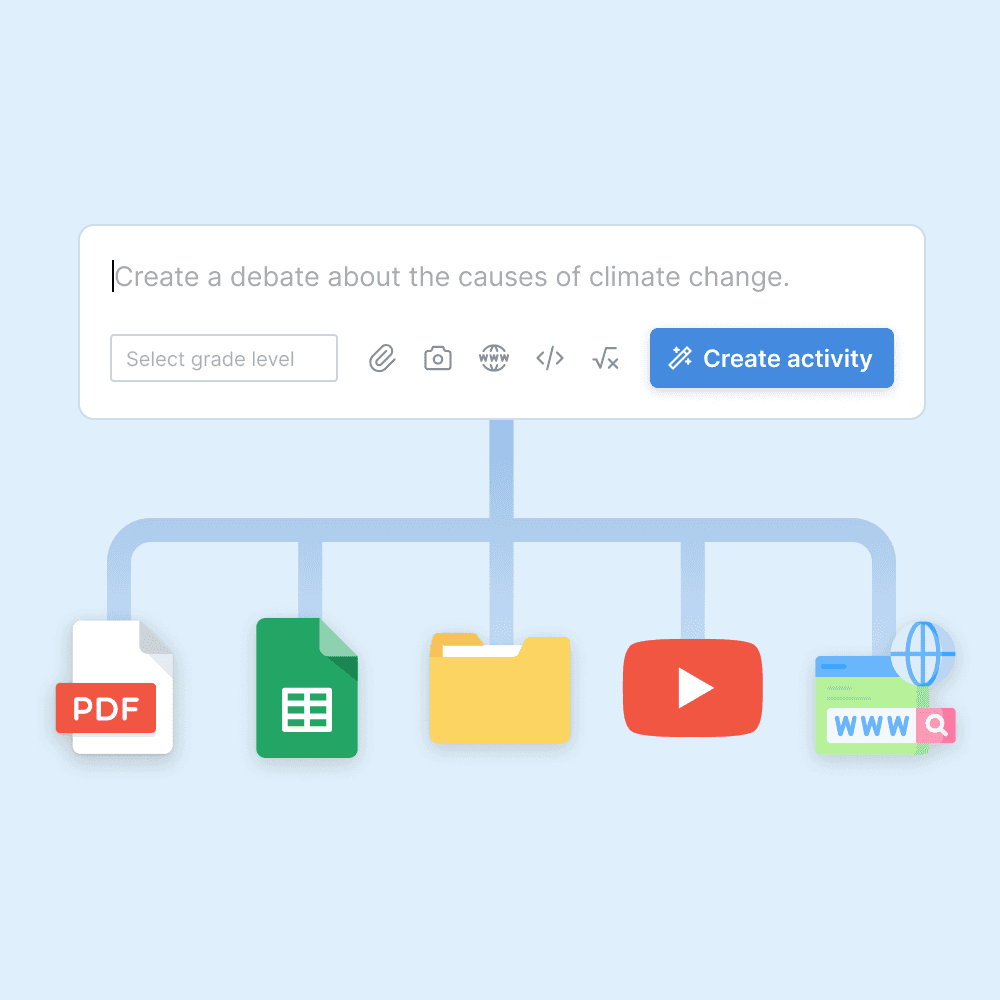
Content upload
Upload PDFs, Word documents, PowerPoint slides, CSV files, and website links for the AI to pull from.
1
of 31

Math accuracy
Flint runs calculations in the background to ensure accuracy on even the most complex math problems, similar to a human tutor verifying work with a calculator.
2
of 31

Web search
Flint can search the web to find accurate and up-to-date info (e.g. current events from news articles).
3
of 31
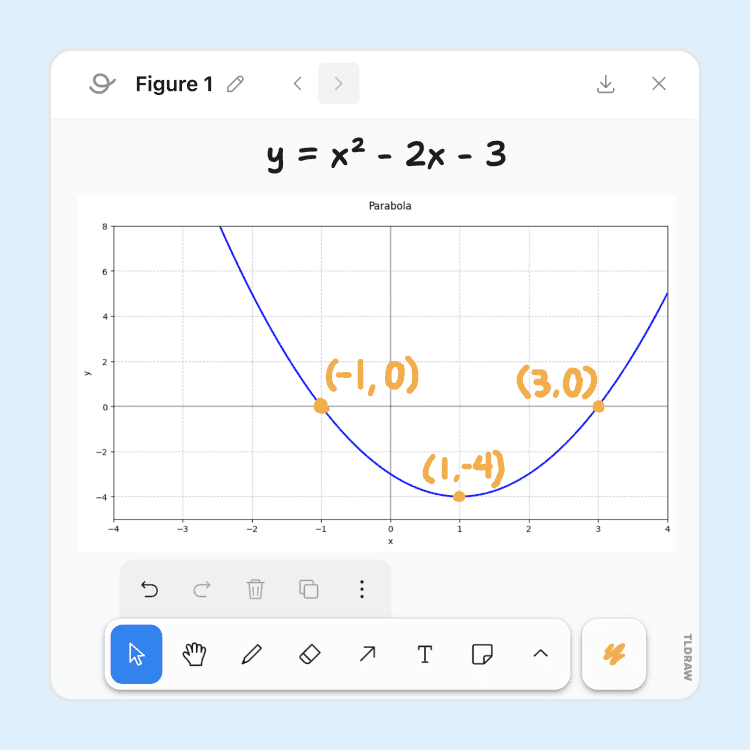
Whiteboard
Students can interact with Flint via a whiteboard to show their work to the AI.
4
of 31

In-line citations
Flint can cite its sources — whether it be from teacher-provided content or web sources the AI found via search — and show the exact excerpt used.
5
of 31

Image processing
Flint can process images to explain diagrams, transcribe written notes, or help students stuck on showing their work on a problem.
6
of 31

Image generation
Flint uses DALL·E 3 to generate AI images to help students visualize scenarios, get inspiration, or create designs.
7
of 31

Evidence-based feedback
When providing feedback after a session, clickable inline citations let students (and teachers) easily identify identify areas of improvement.
8
of 31

Text-to-speech and speech-to-text
Flint can speak in over 50 languages and dialects, and can transcribe speech with 98.5% accuracy.
9
of 31

50+ world languages
World language teachers can select a primary and secondary language for the AI to communicate with students in, as well as a ACTFL or CEFR level.
10
of 31

Code editor
Flint can write and display code in-line in 50+ languages, and includes a built-in code editor with automatic syntax highlighting.
11
of 31

Math formula editor
Flint displays equations in LaTeX formatting and includes a formula editor to let users enter their own equations, in an interface similar to MathType.
12
of 31

Graphing support
Flint can graph equations on 2D or 3D planes to visualize math problems, or help in visualizing simple datasets.
13
of 31

Essay writing feedback
Provide students with inline writing feedback from AI that follows a rubric and guardrails set by the teacher.
14
of 31
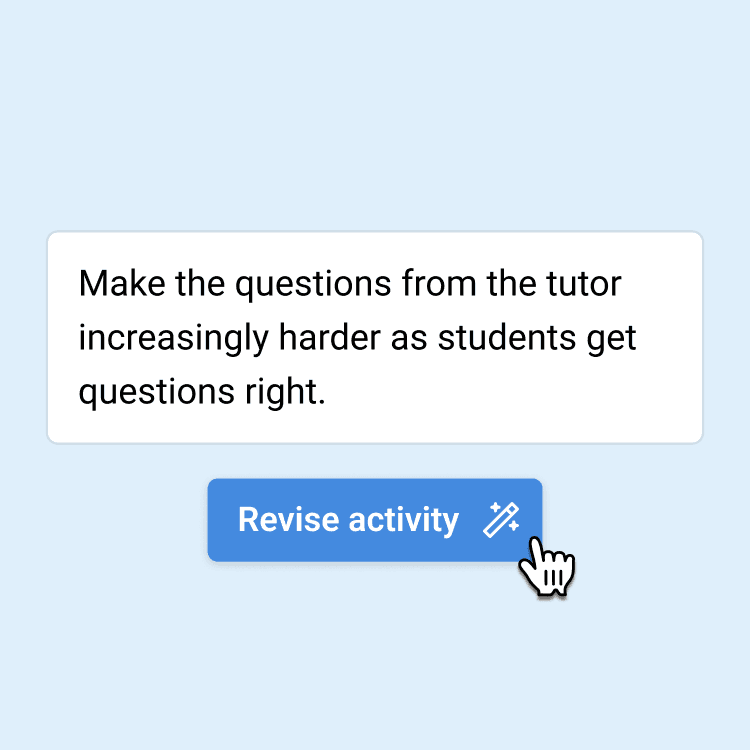
Automatic prompt engineering
Describe what you want in natural language, and let AI do the prompt engineering for you. No prompt engineering skills required.
15
of 31
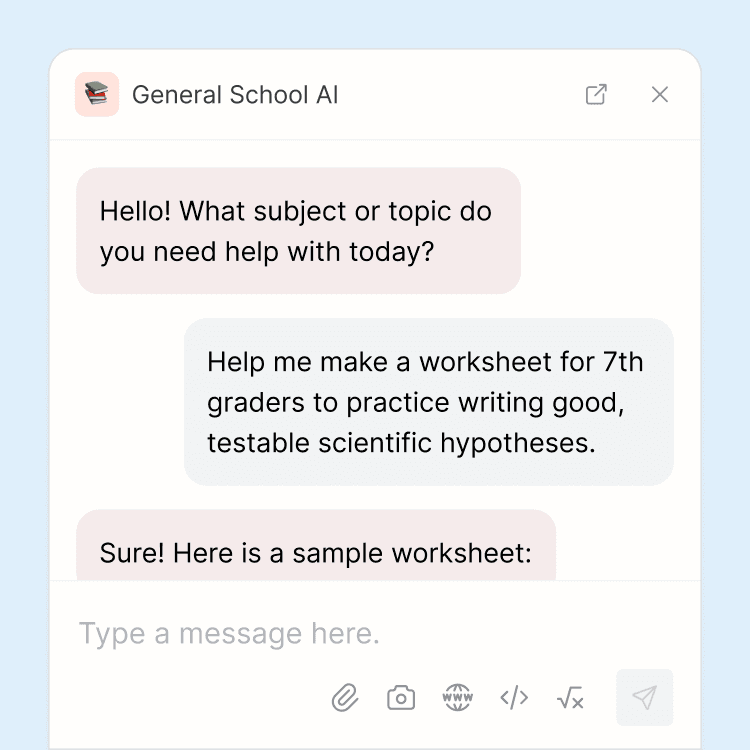
School-wide AI chatbot
Students, teachers, and administrators have 24/7 access to a school-wide AI chatbot that can be used for any purpose, such as extra homework help or for generating classroom materials.
16
of 31

Custom rubrics
Upload rubrics (AP, IB, etc.) for the AI to follow when providing feedback to students, or edit the generated rubric to your liking.
17
of 31

Automated previews
Watch the AI mock up an example student interaction, to see exactly how it would help a struggling student or push an excelling student to go further.
18
of 31
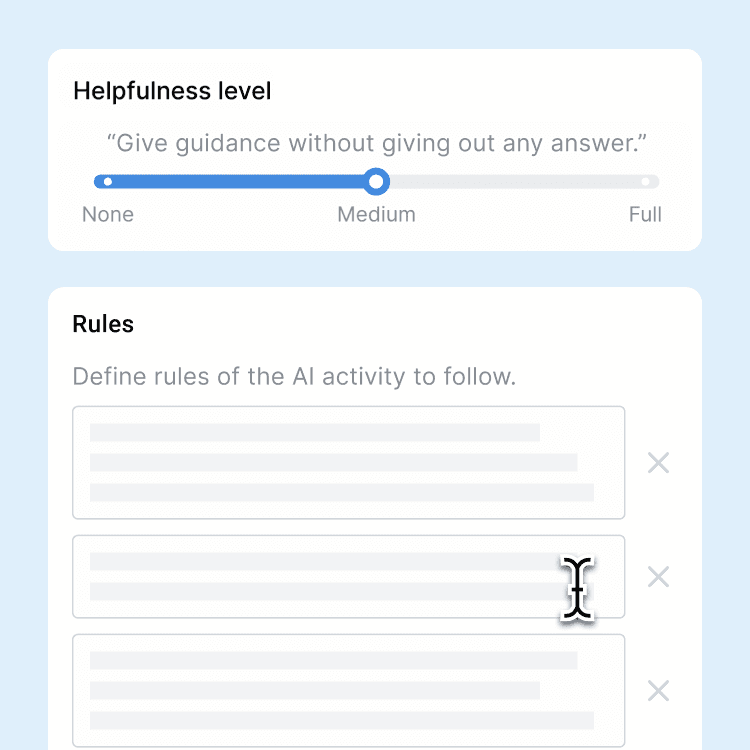
Custom AI guardrails
By default, Flint refuses to provide answers directly or do work on behalf of students. Teachers can customize guardrails the AI follows to make it more or less flexible.
19
of 31
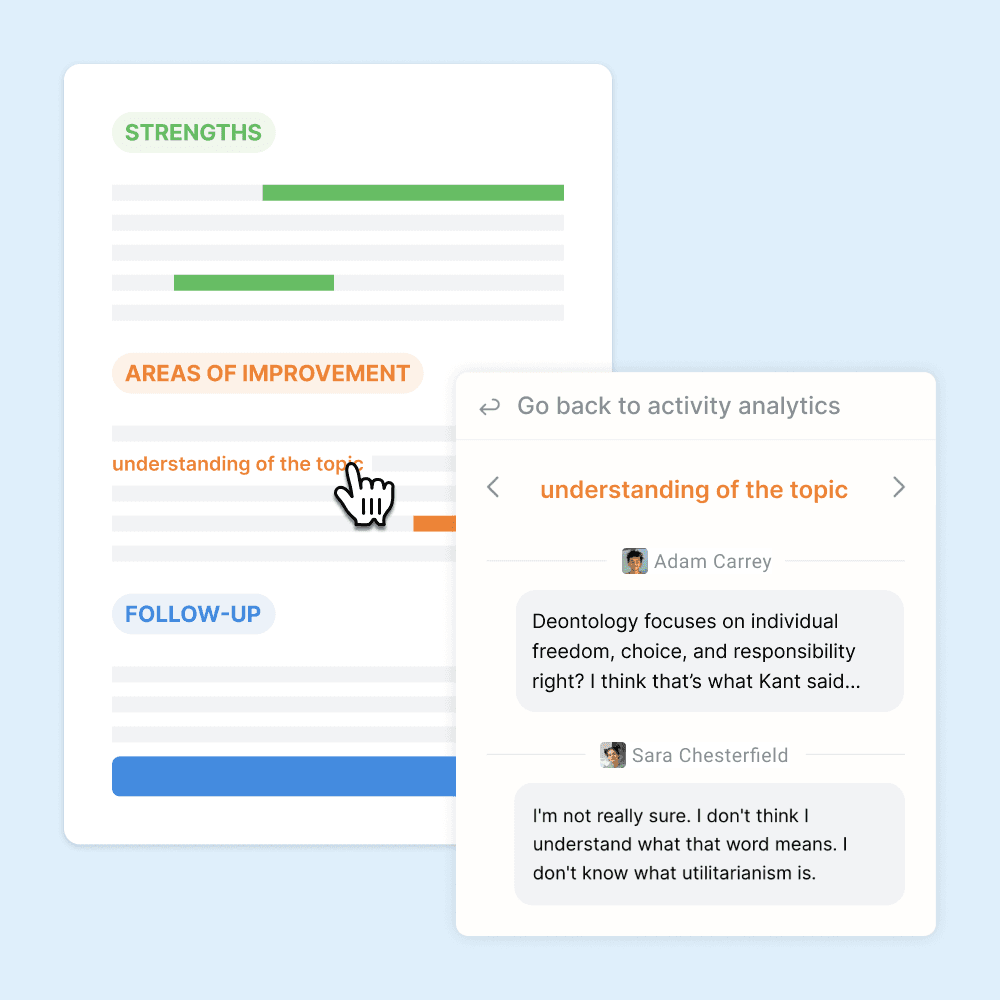
Class-wide summaries
The AI summarizes strengths and areas of improvement for your whole class.
20
of 31

Assignment deadlines
Set a deadline for students to interact with an AI activity, in order to use Flint as an assignment tool.
21
of 31

Timed assignments
Set a time limit for a session with an AI activity.
22
of 31
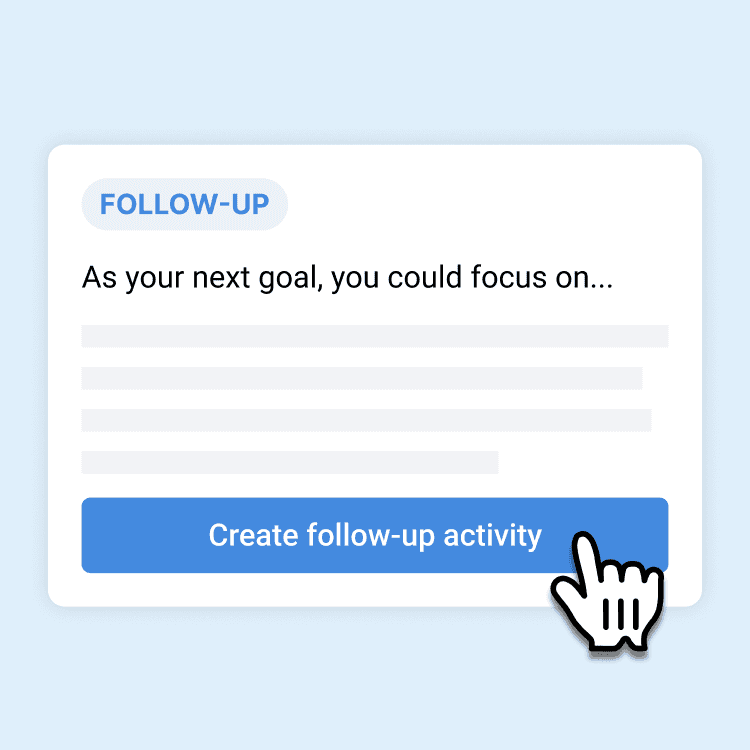
Follow-up AI activities
Based on areas of improvement of an individual student or an entire class, create an AI activity to give personalized extra help.
23
of 31

YouTube video support
Paste a YouTube video link, and Flint can incorporate the transcript as part of its knowledge base.
24
of 31

Print sessions
Print student conversations with the AI, or export as a PDF.
25
of 31

LMS and SIS integrations
Flint supports rostering import via integrations with every major LMS (Canvas, Schoology, Google Classroom, etc.) and SIS (Veracross, Blackbaud, PowerSchool, etc.)
26
of 31

Automatic flagging
Inappropriate messages sent to the AI (language related to violence, harassment, threats, self-harm, sexual content, etc.) are automatically flagged for administrator review.
27
of 31
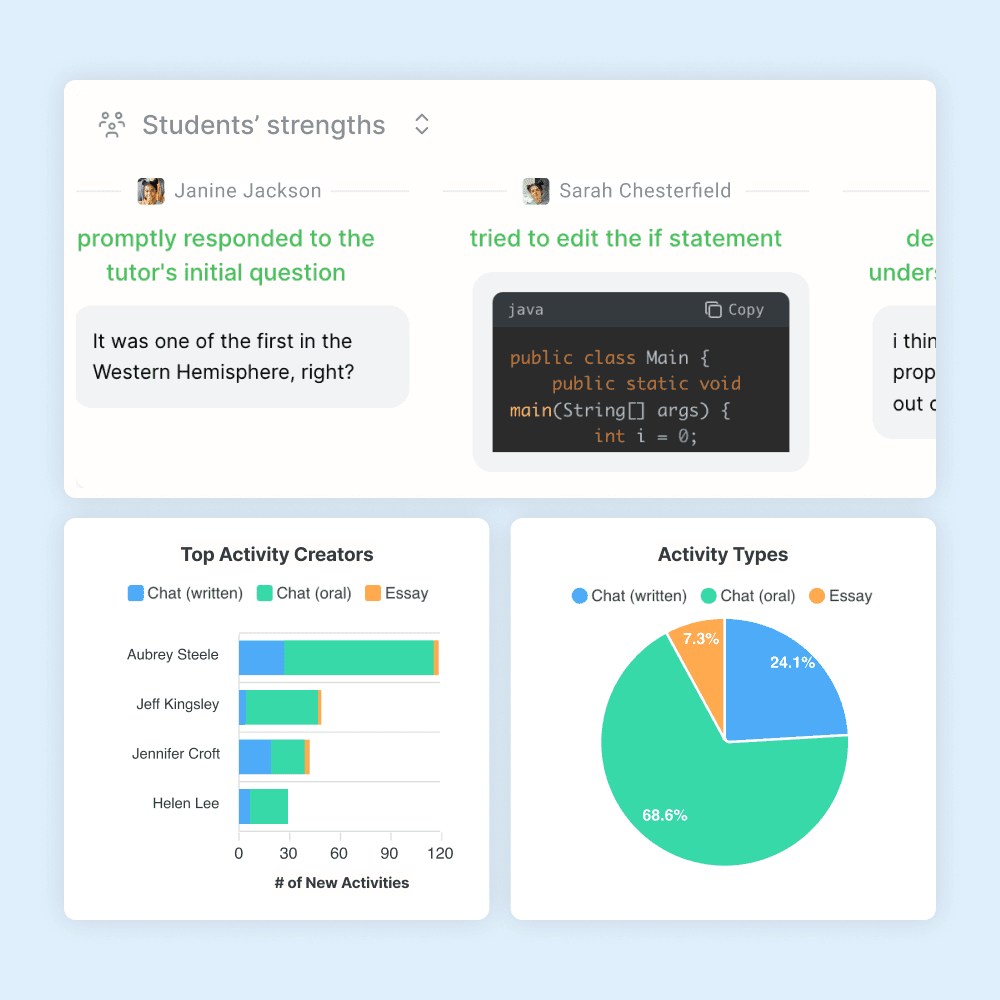
Usage analytics
See how often teachers and students are using Flint, and who the most active users are.
28
of 31

Google and Microsoft SSO
One click sign up via Google or Microsoft, including for students under the age of 13.
29
of 31

Full admin visibility
School admins can see every message that any users (students, teachers, etc.) send back and forth with AI activities on Flint.
30
of 31

State-of-the-art LLMs
Flint uses Claude 3.7 Sonnet in combination with translation, code-based math calculations, and web search for the highest possible accuracy.
31
of 31
Some of Flint’s features includes:
Conversational AI for students to ask questions, revise work, and receive personalized feedback
Student and teacher tools like an AI lesson plan generator, study guide maker, essay grader, language learning support, AI rubric generator, and more.
Graphing calculator with higher accuracy for mathematics and works similar to Wolfram Alpha. Ideal STEM learning and inputting advanced functions.
Whiteboard feature that lets students annotate and draw graphs for all subjects, like supply and demand curves for AP Microeconomics.
Individual student feedback for students sharing strengths, weaknesses, and auto-generated follow-up activities based on their performance
Speech-to-text in 200+ dialects to support multilingual and accessibility needs. Great for world language.
Custom workspace context where Flint uses school values, missions, or standards to shape its response.
While Flint wasn’t built as an LMS, it still connects to the tools schools rely on, integrating with SIS and LMS platforms. This allows teachers and administrators to seamlessly bring AI-powered personalization into the systems they already use.
For teachers and school administrators who want to integrate robust AI capabilities into their school curricula, choosing a a platform like Flint that is AI-centered is the better option.
Toddle can take up to 1–2 Years to fully onboard. Flint works on day one.
Flint is transparent. Toddle leaves questions.
Toddle also does not provide in-line citations, meaning teachers and students have no way of verifying where the information is sourced. This lack of visibility can raise important concerns about academic integrity, especially when AI is being used to support research, writing, and content generation.
Flint addresses this directly by providing in-line citations and clear sourcing when relevant. Whether citing a text, referencing a standard, or linking to external information, Flint makes it easy for educators to see how responses are formed and what sources were used.
During chats and activities, Flint will even signal its process with transparent messages like:
“Let me use a calculator,”
“Let me search the internet,” or
“Let me think about that…”
These behavioral cues promote critical thinking and model transparency for students, an essential step in building AI literacy.
Flint gives teachers free AI access. Toddle gates AI behind paywalls.

While Toddle limits access to AI behind premium plans, Flint empowers all educators with full-feature access right from the start.
Toddle’s AI capabilities are only available on its highest-tier “Ultimate” plan. While its core LMS features are accessible in base tiers, most of Toddle’s AI-powered tools—including AI Tutors, planning assistants, and communication hubs—are reserved for premium subscribers. This restricts the availability of AI to schools or districts with larger budgets and excludes individual educators from accessing key features without institutional buy-in.
Flint offers a more inclusive model. All teachers, regardless of school size, funding, or role, have access to the full Flint platform at no cost. Flint’s free pricing plan includes:
Full access to all AI-powered tools, including lesson planning, activity generation, rubrics, study guides, writing support, and feedback
Up to 80 free student seats per teacher, enabling scalable classroom integration
Student-facing AI features, such as real-time tutoring, revision support, and personalized feedback
No locked features, usage caps, or upgrade barriers
This ensures that educators can immediately benefit from Flint’s capabilities without needing to navigate pricing tiers, negotiate contracts, or delay implementation.
Implement AI for Schools with Flint
Overall, Flint provides a robust, interactive, and safe AI platform that both teachers and students cannot find on Toddle.
You can try out Flint for free, try out our templates, or book a demo if you want to see Flint in action. If you’re interested in seeing our resources, you can check out our AI glossary, PD materials, AI policy library, case studies, and tools library to learn more. Finally, if you want to see Flint’s impact, you can see testimonials from fellow teachers.
If you are from Toddle and you feel like there is an inaccuracy on this page, you can email us at support@flintk12.com.




































